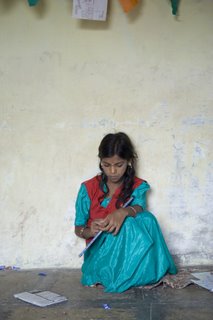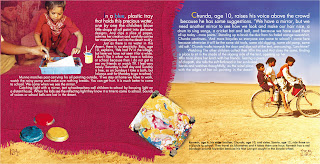


Published in Span Magazine, November-December 2006
Every Wednesday, Monica Jain and a few of her friends gather for a discussion session. For a few minutes, their talk revolves around social and family events, their 50-hour workweeks, their career plans. Then they move to the subject of their meeting: what they can do to improve educational access for India’s underprivileged children. “I think we should organize a community cultural festival as a fundraiser,” one says. Another brings up an education project in Bihar that needs aid. They discuss project proposals they have received from Indian NGOs, and create a plan of action.
While the conversation is commendable in itself, what makes it remarkable is the fact that that Monica and her fellow Philadelphians do not live anywhere near India, many are not Indian and most have rarely, if ever, visited India. Most are neither well-settled professionals nor employees of an NGO. They are primarily university students attending academically rigorous American universities.
Yet despite their demanding schedules, what brings them together is the desire to make a difference in the lives of underprivileged children through Asha for Education, an international collective of individual chapters dedicated to “catalyzing socio-economic change in India through education of underprivileged children” as its Web site states (www.ashanet.org). With 74 chapters spread across the United States, Canada, Europe, Australia, India and Singapore, and disbursement of more than $ 6 million from 1995 to 2004, Asha’s global army of more than 1000 active volunteers is crossing geographical and socio-cultural barriers to make a significant difference in the lives of millions of Indian children.
The success of this non-hierarchical, decentralized, volunteer-run and zero-overhead charity has not gone unnoticed. In 2004, Charity Navigator, an independent charity evaluator with a database of more than 3,000 organizations, ranked Asha for Education as the top charity operating on less than $2 million a year in the field of international relief and development.
For volunteers like Ravi Kandikonda, a memory chip designer in Allen, Texas, stumbling across Asha for the first time was almost like a dream come true. “A few months into my masters (degree program) at Louisiana State University, I realized a great difference between India and the U.S. in terms of having an opportunity to have basic education. I felt like doing something about it and when I saw the Asha Web site, I realized that this organization is exactly what I was looking for to act on my ideas.” Kandikonda is now the Asha Dallas chapter coordinator, spending more than 12 hours a week on Asha-related volunteer activities. Last year, the chapter raised more than $3000 through a concert featuring the Indian contemporary fusion music band Indian Ocean. “It gives me immense satisfaction, that through the organization, I am able to make a difference in the life of at least one child who otherwise would not have been able to go to school,” he says.
Like Kandikonda, many volunteers of Asha’s American chapters get involved while in university. In fact, more than half of the chapters are student-run. Jain, a senior at the University of Pennsylvania and the awareness coordinator for Asha Philadelphia, says, “Being on a college campus where people spend a lot of money on parties and alcohol, I think initiatives like Asha are a good way to channel some of this money for good use. Also, because of the non-hierarchical nature of the organization, we are able to choose projects that we would like to fund and contact them directly about any questions that we have,” she says.
Indeed, the absence of organizational red tape, coupled with Asha’s non-hierarchical structure has enabled a diversity of project types and an extensive geographical outreach within India. There are currently 385 projects spread across 24 states. Some recently funded projects highlight this diversity: In Jharkhand, Asha Stanford funded a science laboratory for Jagriti Vidyalaya, an NGO dedicated to rural reconstruction; in Madhya Pradesh, Asha Seattle funded research on child disabilities in partnership with Sambhavna Clinic, which provides medical support to survivors of the Bhopal gas tragedy.
Seed funding from Asha has often proven critical for the success of unique educational programs that may have been overlooked by mainstream funding agencies. “For our Government School Adoption Program, funding from Asha helped in providing additional teachers to the schools, which was a critical need. Though the schools had an enrollment of 250 students, they only had four teachers appointed by the government,” said Ram Krishnamurthy, coordinator of the program to strengthen government schools in Karnataka.
The ease of joining Asha is part of its appeal. Volunteers can join a chapter close to them, or if none exists, they can start one after a period of affiliation with an established chapter. The prerequisite for being a volunteer is a desire to do something for underprivileged children in India by raising funds for NGOs in India that are working to improve their plight. A chapter is free to decide what projects to fund, as long as the programs are secular and have an education component. The volunteers in each chapter democratically select a proposal to support in each funding cycle, and these must be reviewed through the main Asha data base—monitored by volunteers—before funds can be disbursed.
Volunteers in Asha’s chapters outside India recognize the limitations of monitoring projects from thousands of miles away. That’s where Asha’s large Indian volunteer base proves helpful. “Asha chapters in different partsof the world often contact our volunteers for information on projects in our vicinity. We also help them conduct site visits, monitor projects and file site reports,” says Sharad Jaiswal, chapter coordinator of Asha Bangalore.
“What attracts me to Asha is that, due to its decentralized structure, there is 100 percent transparency of funding, 100 percent efficiency as all the money is spent in India, and total oversight over projects because of the mandatory auditing requirements,” says James Minter, fundraising coordinator for the Asha chapter in Washington, D.C.
Though raising funds for education-related projects in India is central to Asha’s work, volunteers see raising awareness within their own countries as an equally important focus. “Asha has been a useful avenue for me to act on my interest in helping underprivileged children in India. In addition, it has greatly increased my own awareness about social issues in developing countries like India,” says Minter, who spends four months each year conducting site visits for projects funded by his and other Asha chapters. On his most recent trip in 2006, he spent three months viewing projects and learning about the socio-economic conditions of people living in Uttaranchal, Bihar, Jharkhand and West Bengal. He’s excited about his chapter’s upcoming awareness and fundraising events: an Indian documentary film festival, a marathon, and a concert.
“I had to risk losing my job to volunteer, and my family is against the unpaid work and use of personal resources,” he says. “The most rewarding part of my work has been visiting project sites and seeing the faces of children light up. Volunteering doesn’t seem like work to me, but is something that springs out of my soul.”
****************
The beautiful photos are courtesy Asha Zurich.
About the photos:
Two semi-professional photographers, André Urech (24) and Elia Marinucci (23) traveled in Autumn 2005 to India, in order to document development projects in the area of education. They focused on projects supported by Asha Zurich. Their intention was to document the
projects' contribution for the development of India and to present the information to Switzerland graphically and artistically.
The three photos were taken during classes at Akshardeep, which is an alternative school program initated by the NGO Swadhar in June 1998. This project is specially meant for children of sex workers and migrant labor in the age group of 6-12. They run 10 NFE (Non Formal
Education) schools in Pune Municipal Corporation (PMC) area and 10 in Pune Chinchwad Municipal Corporation (PCMC) area. Asha Zurich is funding the running of the 10 classes.












